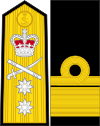| Rear admiral | |
|---|---|
 Flag of a rear admiral, Royal Navy | |
 Insignia shoulder board and sleeve lace for rear admiral | |
| Country | |
| Service branch | |
| Abbreviation | RADM / R Adm |
| Rank | Two-star |
| NATO rank code | OF-7 |
| Next higher rank | Vice-admiral |
| Next lower rank | Commodore |
| Equivalent ranks | |
Rear admiral (RAdm) is a flag officer rank of the Royal Navy. It is immediately superior to commodore and is subordinate to vice admiral. It is a two-star rank and has a NATO ranking code of OF-7.
Contents
The equivalent rank in the British Army and Royal Marines is major-general; and in the Royal Air Force it is air vice-marshal.

